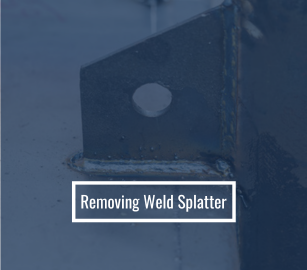
Removing Weld Splatter

The cleanliness of the weld region affects the creation of the correct pretreatment conversion coating and the adhesion of subsequent coatings to welds. Different types of inorganic soils can be produced depending on the welding technique used.
These inorganic soils must be eliminated to guarantee the effectiveness of pretreatment and coating procedures. This article describes the welding slag and splatter soils produced during welding and suggests an effective cleanup technique for each.
WHAT IS WELD SPLATTER?
Small molten metal fragments released from the weld puddle and sticking to the base metal surface are known as weld splatter. A disruption in the molten weld puddle during wire transfer into the weld is why weld splatter forms. Inadequate shielding gas, filthy base metal, excessively long travel rates, excessively long wires, or the connection between amperage and voltage are the usual culprits for the disturbance. This is typically observed when the amperage is too high for a specific wire and gas combination. In addition, the welding voltage is too high or low.
MAKE SURE YOUR SURFACE IS ADEQUATELY PREPPED
Use only pure base metals for welding, free of coatings or rust. This rule applies to all welding techniques. Before welding, you can remove coatings or impurities.
HOW TO REMOVE WELD SPLATTER?
GRINDING AND SANDING
Mechanical techniques eliminate welding splatters. Standard techniques include grinding, sanding, blasting, and scraping. Abrasive wheels, belts, and wire power brushes (manual or powered) can all be used for grinding and sanding.
Typically, assemblies with several exposed weld surfaces that the blast material can quickly contact are subjected to blasting. Blasting might involve mechanically or airtightly propelled abrasive blast cleaning or abrasive media blasting.
CHIPPING HAMMER OR CHISEL
Scraping or chipping is an easy way to remove splatter that is simple to clean up. A chipping hammer or chisel is often the best tool.
ANTI-SPLATTER
Using anti-splatter chemicals can also reduce or eliminate splatter adhesion to the base metal. The anti-splatter is applied to the region that must be welded, leaving a shielding layer that stops the splatter from adhering after it hardens.
HAMMER CHISEL WITH A SLIDE
It is a slide hammer with a chisel attached to the end. Therefore, you can use it to place controlled taps in nearly impossible-to-reach spots. This is rather than pulling as slide hammers typically do.
Not much is required to remove the welding splatter. You should be able to handle most situations with an anti-splatter spray, a chipping hammer, a cold chisel, a flap disc, and a power filer.
WELD SPLATTER REDUCTION
If you have any welding expertise and are familiar with properly setting up your gas flow, choosing the correct wire speeds, and angering your welding stick or gun, you know splatter will still occur. Even though you cannot completely avoid and prevent weld splatter from sticking, you can strive to minimize it.
When welding, reducing splatter will produce a smoother weld and save you time during the blending and finishing process.



































































